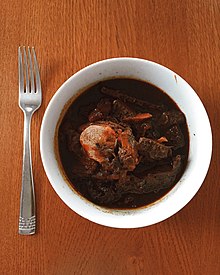Olla capsicorum

Olla capsicorum[1] (Anglice pepper-pot) est ferculum in insulis Caribaeis et Guiana saepe inlatum. Idem fere ferculum Philadelphiae sub specie cibi viarii saeculo XIX ineunte venditabatur. Verbis satyricis Eduardus Ward anno fere 1698 rettulit:
- They make a rare soop they call pepper-pot: it's an excellent breakfast for a salamander ... Three spoonfuls so inflam'd my mouth, that had I devour'd a peck of horse-radish ... I could not have been more importunate for a drop of water to coole my tongue.[2]
Anno 1849 Georgius Ruxton, qui iter maritimum in Mexicum per insulam Barbatam faciebat, ollam capsicorum gustavit, a delicious compound of flesh, fish and fowl, piqué with all the hot peppers and condiments the island produces, and mystified in a rich black sauce,[3] sed anno 1873 Carolus Rampini, Chapelton in oppido Iamaicae morans, ferculum curiosius descripsit:
- For here was I not introduced to 'pepper-pot' and mountain mullet? Not the Demerara pepper-pot with its evil-smelling and still more evil-tasting cassareep sauce and its hereditary pipkin, but a rich, succulent potage, a very Meg merrilees broth of pork and beef and fowl, ochroes and calaloo (the West Indian spinach), peppers, crayfish and negro yam; in colour a drak green, with the scarlet prawns appearing through the chaotic mass not unpicturesquely ... With the negroes, pepper-pot is a compound of the most heterogeneous description. Prawns or crayfish of some kind are de rigueur, but bamboo tops, cotton-tree tips, cabbage, pimpernel, pulse, and even the buds of the night-blowing cereus, occasionally find a place in the concoction ... Peppers and annatto were not stinted. The colouring was brilliant and the pungency intense.[4]
Praeceptum breve anno 1913 datum est: Get an earthen vessel. To every quart of water add three tablespoonsful of pure cassareep with salt to taste and a handful of bird peppers, or some cayenne pepper. It should be warmed evey day and something should be added each day.[5]
Notae
[recensere | fontem recensere]- ↑ Haec appellatio a Vicipaediano e lingua indigena in sermonem Latinum conversa est. Extra Vicipaediam huius locutionis testificatio vix inveniri potest.
- ↑ Ward (1698)
- ↑ Ruxton (1849) p. 6
- ↑ Rampini (1873)
- ↑ Harris (1913) p. 37
Bibliographia
[recensere | fontem recensere]
- Fontes antiquiores
- 1698 : Edward Ward, A Trip to Jamaica: with a true character of the people and island 3a ed. (Londinii) pp. 14-15
- 1707-1725 : Hans Sloane, A Voyage to the Islands Madera, Barbadoes, Nieves, S. Christophers and Jamaica (2 voll. Londinii) vol. 1 pp. xviii-xix, cxxvii, vol. 2 p. 193
- 1719 : George French, An Answer to a Libel intitled, A Letter to Mr G. French ... Londinii: J. Bettenham (p. 197 in nota subiuncta apud Google Books)
- 1740 : [Charles Leslie], A New History of Jamaica, from the earliest accounts, to the taking of Porto Bello. Londinii: J. Hodges, 1740 (p. 306 apud Google Books)
- 1803 : Thomas Winterbottom, An account of the native Africans in the neighbourhood of Sierra Leone. Londinii: Hatchard vol. 1 p. 64 ("The okra, hibiscus esculentus, which enters into the composition of the celebrated pepper pot of the West Indies, is often used for the same purpose by the natives")
- 1813 : John Gabriel Stedman, Narrative of a Five Years' Expedition against the Revolted Negroes of Surinam (Londinii: J. Johnson, 1813) vol. 1 pp. 405-406; vol. 2 p. 292
- 1849 : George F. Ruxton, Adventures in Mexico and the Rocky Mountains. Londinii: John Murray (Textus apud Google Books)
- 1873 : Charles Rampini, Letters from Jamaica, the land of streams and woods (Edinburgi: Edmonston and Douglas) pp. 64-65
- Eruditio
- F. G. Cassidy, R. B. Le Page, Dictionary of Jamaican English (Cantabrigiae: Cambridge University Press, 1967) s.v. pepper-pot
- Darrin Duford, "Journey by Bottle: Uncovering the Allure of Guyanese Cassareep" in Gastronomica vol. 12 no. 4 (2012) pp. 27–30
- Candice Goucher, Congotay! Congotay! A Global History of Caribbean Food (Londinii: Taylor & Francis, 2014) p. 57
- William Woys Weaver, "From Turtle to Tripe: Philadelphia Pepperpot, A Street Food from the West Indies" in Harlan Walker, ed., Oxford Symposium on Food and Cookery 1991: Public Eating (Totenais: Prospect Books, 1992) pp. 287–292
- Praecepta culinaria
- 1913 : W. Harris, Notes on Fruits and Vegetables in Jamaica. Regiopoli: Govt. Printing Office